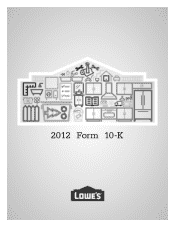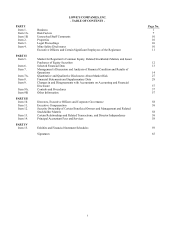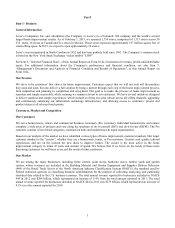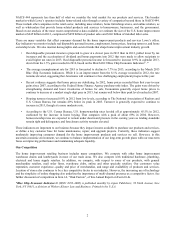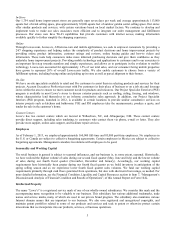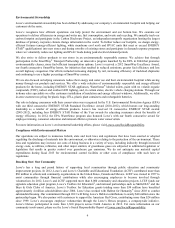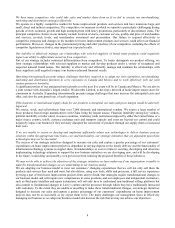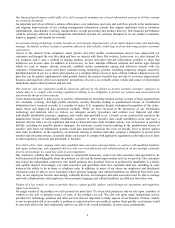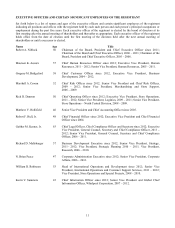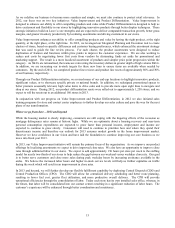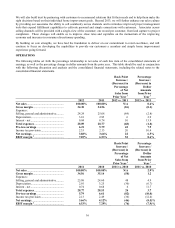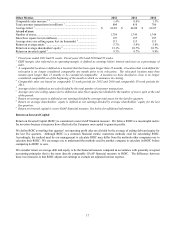Lowe's 2012 Annual Report Download - page 21
Download and view the complete annual report
Please find page 21 of the 2012 Lowe's annual report below. You can navigate through the pages in the report by either clicking on the pages listed below, or by using the keyword search tool below to find specific information within the annual report.
7
Available Information
Our annual report on Form 10-K, quarterly reports on Form 10-Q, current reports on Form 8-K and amendments to those
reports filed or furnished pursuant to Section 13(a) or 15(d) of the Securities Exchange Act of 1934, as amended, are made
available free of charge through our internet website at www.Lowes.com/investor, as soon as reasonably practicable after
such documents are electronically filed with, or furnished to, the Securities and Exchange Commission (SEC). The public
may also read and copy any materials the Company files with the SEC at the SEC’s Public Reference Room at 100 F
Street, NE, Washington, DC 20549. Information on the operation of the Public Reference Room may be obtained by
calling the SEC at 1-800-SEC-0330. The SEC maintains an Internet site, www.sec.gov, that contains reports, proxy and
information statements, and other information regarding issuers that file electronically with the SEC.
Item 1A - Risk Factors
We have developed a risk management process using periodic surveys, external research, planning processes, risk
mapping, analytics and other tools to identify and evaluate the operational, financial, environmental, reputational, strategic
and other risks that could adversely affect our business. For more information about our risk management process, which is
administered by our Chief Risk Officer and includes developing risk mitigation controls and procedures for the material
risks we identify, see the description included in the proxy statement for our annual meeting of shareholders (as defined in
Item 10 of Part III of this Annual Report on Form 10-K) under “Board’s Role in the Risk Management Process”.
We describe below all known material risks that could adversely affect our results of operations, financial condition or
business prospects. These risk factors may change from time to time and may be amended, supplemented or superseded by
updates to the risk factors contained in our future periodic reports on Form 10-K, Form 10-Q and reports on other forms we
file with the Securities and Exchange Commission. All forward-looking statements about our future results of operations or
other matters made by us in this Annual Report on Form 10-K, in our Annual Report to Lowe’s Shareholders and in our
subsequently filed reports to the Securities and Exchange Commission, as well as in our press releases and other public
communications, are qualified by the risks described below.
Our sales are dependent upon the health and stability of the general economy.
General economic factors and other conditions, both domestically and internationally, may adversely affect the U.S.
economy, the global economy and our financial performance. These include, but are not limited to, periods of slow
economic growth or recession, volatility and/or lack of liquidity from time to time in U.S. and world financial markets and
the consequent reduced availability and/or higher cost of borrowing to Lowe’s and its customers, the “sequester” and
related governmental spending and budget matters, slower rates of growth in real disposable personal income, sustained
high rates of unemployment, high consumer debt levels, increasing fuel and energy costs, inflation or deflation of
commodity prices, natural disasters, acts of terrorism and developments in the war against terrorism in Asia, the Middle
East and other parts of the world. The continuing sluggish pace of the recovery from the deep global recession could
continue to have an adverse effect on the rate of growth of discretionary spending by consumers and the share of such
discretionary spending on home improvement products and services.
Adverse changes in economic factors specific to the home improvement industry may negatively impact the rate of growth
of our total sales and comparable sales.
Sales of many of our product categories and services are driven by the activity level of home improvement projects. Slowly
recovering home prices, the large number of households that continue to have little or negative equity, slowly declining
mortgage delinquency and foreclosure rates, restrictions on the availability of mortgage financing, slower household
formation growth rates, and lower housing turnover through existing home sales, have limited, and may continue to limit,
consumers’ discretionary spending, particularly on larger home improvement projects that are important to our business.
Changes in existing or new laws and regulations or regulatory enforcement priorities could adversely affect our business.
Laws and regulations at the local, regional, state, federal and international levels change frequently and the changes can
impose significant costs and other burdens of compliance on our business and our vendors. Any changes in regulations, the
imposition of additional regulations, or the enactment of any new legislation that affect employment/labor, trade, product
safety, transportation/logistics, energy costs, health care, cyber-security, tax or environmental issues, could have an adverse
impact, directly or indirectly, on our financial condition and results of operations. Changes in enforcement priorities by
governmental agencies charged with enforcing existing laws and regulations can increase our cost of doing business. In
addition, we are subject to various procurement regulations applicable to our contracts for sales to the U.S Government and
could be adversely affected by changes in those regulations or any negative findings from an audit or investigation.



